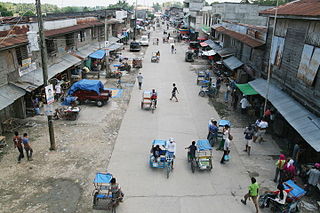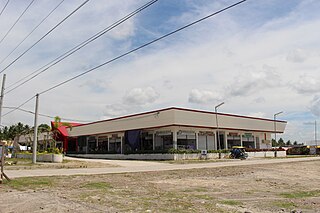
Maguindanao was a province in the Philippines located in the Bangsamoro Autonomous Region in Muslim Mindanao (BARMM). Since 2014 the provincial capital is Buluan but the legislative branch of the provincial government, the Sangguniang Panlalawigan, convenes in the old provincial capitol in the town of Sultan Kudarat. It borders Lanao del Sur to the north, Cotabato to the east, Sultan Kudarat to the south, and the Illana Bay to the west.

Cotabato City, officially known as the City of Cotabato, is a 3rd class independent component city in the Bangsamoro Autonomous Region in Muslim Mindanao, Philippines. According to the 2020 census, it has a population of 325,079 people, making it as the most populated city under the independent component city status.

Ampatuan, officially the Municipality of Ampatuan, is a 4th class municipality in the province of Maguindanao del Sur, Philippines. According to the 2020 census, it has a population of 28,941 people.

Datu Odin Sinsuat, officially the Municipality of Datu Odin Sinsuat, is a 2nd class municipality and capital of the province of Maguindanao del Norte, Philippines. According to the 2020 census, it has a population of 116,768 people.

Datu Piang, officially the Municipality of Datu Piang, is a 2nd class municipality in the province of Maguindanao, Philippines. According to the 2020 census, it has a population of 28,380 people.

Paglat, officially the Municipality of Paglat, is a municipality in the province of Maguindanao, Philippines. According to the 2020 census, it has a population of 18,727 people.

Shariff Aguak, officially the Municipality of Shariff Aguak, is a 3rd class municipality in the province of Maguindanao, Philippines. According to the 2020 census, it has a population of 33,982 people.

Sultan Kudarat, officially the Municipality of Sultan Kudarat, is a 1st class municipality and legislative capital of the province of Maguindanao, Philippines. According to the 2020 census, it has a population of 105,121 people.

Sultan sa Barongis, officially the Municipality of Sultan sa Barongis, is a 2nd class municipality in the province of Maguindanao del Sur, Philippines. According to the 2020 census, it has a population of 24,476 people.

Talayan, officially the Municipality of Talayan, is a 4th class municipality in the province of Maguindanao del Sur, Philippines. According to the 2020 census, it has a population of 34,156 people.

Mamasapano, officially the Municipality of Mamasapano, is a 5th class municipality in the province of Maguindanao, Philippines. According to the 2020 census, it has a population of 27,807 people.

Pagalungan, officially the Municipality of Pagalungan, is a 1st class municipality in the province of Maguindanao, Bangsamoro, Philippines. According to the 2020 census, it has a population of 46,277 people.

Datu Saudi Ampatuan, officially the Municipality of Datu Saudi Ampatuan, is a 4th class municipality in the province of Maguindanao, Philippines. According to the 2020 census, it has a population of 31,060 people.

Datu Unsay, officially the Municipality of Datu Unsay, is a 5th class municipality in the province of Maguindanao, Philippines. According to the 2020 census, it has a population of 12,890 people.

Guindulungan, officially the Municipality of Guindulungan, is a municipality in the province of Maguindanao, Philippines. According to the 2020 census, it has a population of 24,933 people.

Datu Blah T. Sinsuat, officially the Municipality of Datu Blah T. Sinsuat, is a municipality in the province of Maguindanao, Philippines. According to the 2020 census, it has a population of 28,243 people.

Datu Anggal Midtimbang, officially the Municipality of Datu Anggal Midtimbang, is a municipality in the province of Maguindanao, Philippines. According to the 2020 census, it has a population of 28,224 people.

Datu Hoffer Ampatuan, officially the Municipality of Datu Hoffer Ampatuan, is a municipality in the province of Maguindanao, Philippines. According to the 2020 census, it has a population of 26,660 people.
Datu Salibo, officially the Municipality of Datu Salibo, is a municipality in the province of Maguindanao, Philippines. According to the 2020 census, it has a population of 18,795 people.

Shariff Saydona Mustapha, officially the Municipality of Shariff Saydona Mustapha, is a municipality in the province of Maguindanao, Philippines. According to the 2020 census, it has a population of 25,080 people.
























